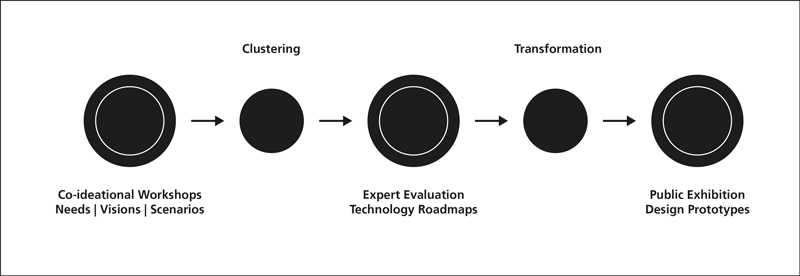by Martina Schraudner and Marie Heidingsfelder (Fraunhofer IAO)
Our research project Shaping Future presents a methodology for setting need-oriented research agendas in the field of human-machine interaction.
Innovative technologies must reflect their socio-technical context and conditions to be transferred into technical innovations; emerging from a techno-scientific world, they must be embedded into social practices to be successful. Agenda-setting processes have conventionally been determined by specialists, largely because technology foresight faces a double-bind problem known as the ‘Collingridge dilemma’. The full functionality and impact of a new technology cannot be easily predicted until this technology is sufficiently developed and widely used, after which time it is difficult to make substantial changes [1]. In addition, current language-based methods predispose one to rely on pre-existing terminology and schemas and thereby restrict one’s openness and creativity while trying to picture desirable future developments.
In the project ‘Shaping Future’ we developed an original and interdisciplinary methodology to integrate laypersons into this otherwise mainly expert-driven process [2]. This process comprises three major stages connected by two transfer stages, clustering and transformation (see Figure 1). Each of these stages requires its own methodological approaches. (i) In a series of co-ideational workshops, we needed to enable laypersons to articulate their preferences toward technological advances and the directions they might take. (ii) For the professional utilisation of these preferences, we needed to develop a method to enable researchers from different backgrounds to understand each other, to interact on equal terms and to find interdisciplinary solutions based on the layperson’s needs. (iii) Finally, for the dissemination of results, we publicly displayed a number of design fiction prototypes, developed by professional designers, in order to initiate a widespread discourse about desirable technological advances. Thus, the developed methodology can open the processes of technology development and agenda-setting to the general public.

Figure 1: The Shaping Future process.
The current results of Shaping Future suggest that methods of participatory design and the social sciences can be adopted and combined for participatory agenda-setting processes far beyond the field of human-machine interaction [3]:
- Participatory prototyping provides a particularly effective technique for enabling laypersons to realise and explore their preferences toward prospective, as yet unknown, technological advances and the methods by which they are produced. Overall, workshop participants considered this technique to be the key to the entire process. Building upon approaches from both participatory design and the social sciences, we developed an original, methodologically sound procedure for data analysis. With the help of this procedure, we extrapolated laypersons’ preferences from the aggregate data, comprising tangible objects, written descriptions, audios, and videos, and clustered these preferences. This refinement rendered the lay input not only understandable and appealing to participating specialists but also generally suitable for the purposes of technology development.
- By transforming this input, participating specialists were, in turn, able to outline promising research trajectories. Going beyond the limits of language, our design-based method enabled them to transcend everyday practicality, professional terminology and ‘silo-knowledge’[4].
- By publicly displaying design fiction prototypes, that give a physical shape to the layperson’s needs and the expert’s evaluation, we intend to reach a larger audience and ultimately engage a larger number of people in technology foresight.
The methodology allows us to go beyond preference articulation and to open up a process of collaborative sense-making in the context of future technologies.
The Shaping Future project is funded by the German Federal Ministry for Education and Research (BMBF), project ID 16I1639.
References:
[1] A. F. Blackwell, et al.: “Radical innovation: crossing knowledge boundaries with interdisciplinary teams”, No. UCAM-CL-TR-760, University of Cambridge, Computer Laboratory, 2009.
[2] M. Heidingsfelder, et al.: “Shaping future – Adapting design know-how to reorient innovation towards public preferences”, Technological forecasting and social change, 101, 291-298, 2015.
[3] M. L. Heidingsfelder, F. Schütz, S. Kaiser: “Expanding participation participatory design in technology agenda-setting”, in Proc. of the 14th Participatory Design Conference: Short Papers, Interactive Exhibitions, Workshops-Volume 2, 25-28, ACM, 2016.
Please contact:
Martina Schraudner, Fraunhofer IAO- Fraunhofer Center for Responsible Research and Innovation, Berlin Germany











